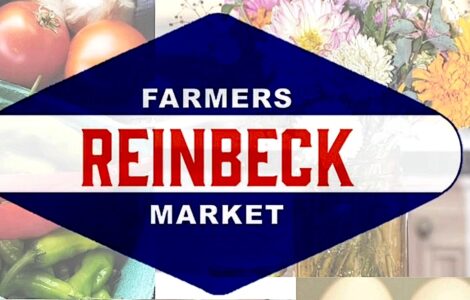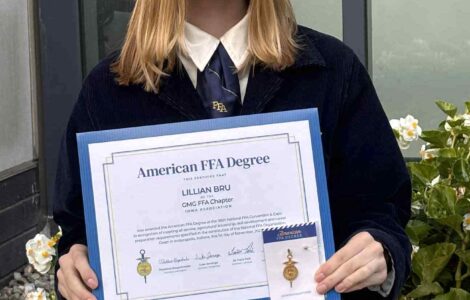Unwinding History: Traer Livestock Auctions
- A business postcard for Traer Sales Company, located south of Traer, depicting the new barn which was built in 1948. The barn was burned in 1984 to make way for Traer Manufacturing. PHOTO COURTESY OF TRAER HISTORICAL MUSEUM
- The five-truck fleet of Cooper & Dalziel pictured in 1949. From left, Leonard Ruzicka, Wilfred “Boob” Speirs, Rudy Ruzicka, Dean McConnel, Elza Buchanan, and Earl Hoeppner. The general livestock trucking business sold feed at 408 Second Street, currently the Wild Hair Salon in downtown Traer. PHOTO COURTESY OF TRAER HISTORICAL MUSEUM
- Cooper & Dalziel livestock drivers pictured in 1959. From left, Earl Hoeppner and his daughter Jane, Harold Bergman, Wilfred Speirs and Shep, LeRoy Staker, and Dean McConnell. PHOTO COURTESY OF TRAER HISTORICAL MUSEUM
- The Traer livery stable; date unknown. The first livestock sale barn in Traer was built in 1935 by Floyd Smith. The office and scale were located on Berlin Street at the junction with the alley behind Woodlawn Avenue. PHOTO COURTESY OF TRAER HISTORICAL MUSEUM
- An aerial view of Traer Sales Company located south of Traer. PHOTO COURTESY OF TRAER HISTORICAL MUSEUM
- Employees with Traer Sales Company pictured in 1959. From left, Leroy Staker, Harold Bergman, Wilfred “Boob” Speirs. Earl “Hep” Hoeppner, Kenneth Gates, Dean McConnell, and Wesley Rebik. PHOTO COURTESY OF TRAER HISTORICAL MUSEUM
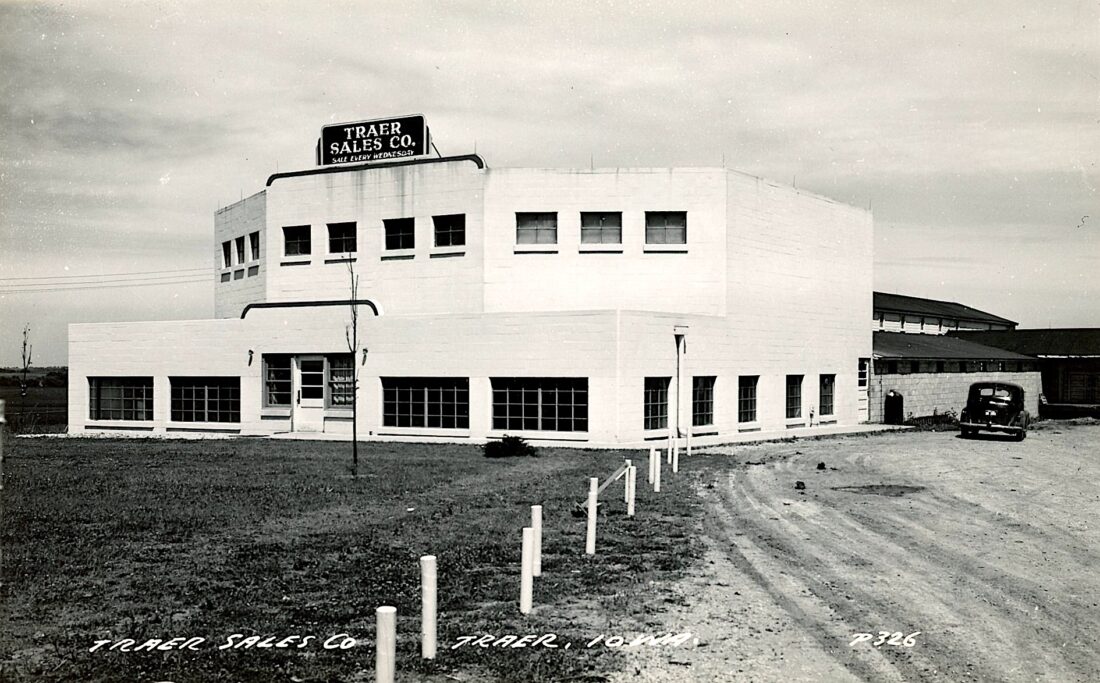
A business postcard for Traer Sales Company, located south of Traer, depicting the new barn which was built in 1948. The barn was burned in 1984 to make way for Traer Manufacturing. PHOTO COURTESY OF TRAER HISTORICAL MUSEUM
Sun Courier Note: Unwinding History is an occasional series by Traer Historical Museum president George Kadrmas originally published by the North Tama Telegraph.
TRAER – Livestock auctions in the early days in northern Tama County were typically held by livestock breeders. Occasionally, auctions were held at a livery stable in Traer. The first livestock sale barn in Traer was built in 1935 by Floyd Smith. The office and scale were located on Berlin Street at the junction with the alley behind Woodlawn Avenue. The sale barn was just west of the scale. Sales were held regularly for two years, then the barn sat idle for a year.
In 1939 the livestock buying firm of Alfon Strohbehn & Roy Cooper and the livestock trucking and buying firm of John Kubik & Merle Dalziel purchased the property. The barn was extensively remodeled and operated for 10 years.
Merle Dalziel and Roy Cooper erected a large new barn south of Traer in 1948. Kenneth Gethmann of Gladbrook built the new barn. It was 60 feet wide by 54 feet deep, constructed of concrete blocks. The entry and the lobby were in the center of the building with men’s and women’s restrooms. Off the lobby to the north was a private office and clerk’s office. To the south was a 24-by-28 foot lunch room with a kitchen at the rear. The lunchroom had a horseshoe-shaped counter with 26 stools and four large booths built by Kenneth Smith of Traer. Andrew and Walter Richmond painted the interior and signs. Hoeg & Ames Well Drillers from Lincoln drilled a 346-foot-deep well with a Fairbanks Morse pumping system to provide water for the facility.
The bleachers in the sales arena seated nearly 500 and everyone had a good view of the sale ring. The animals were weighed, brought in the ring, sold, and run out the other side. There were 58 pens under roof with an additional 37 uncovered pens in the back. Loading docks were located on the south side of the barn and nearly three acres of parking, covered with crushed rock.
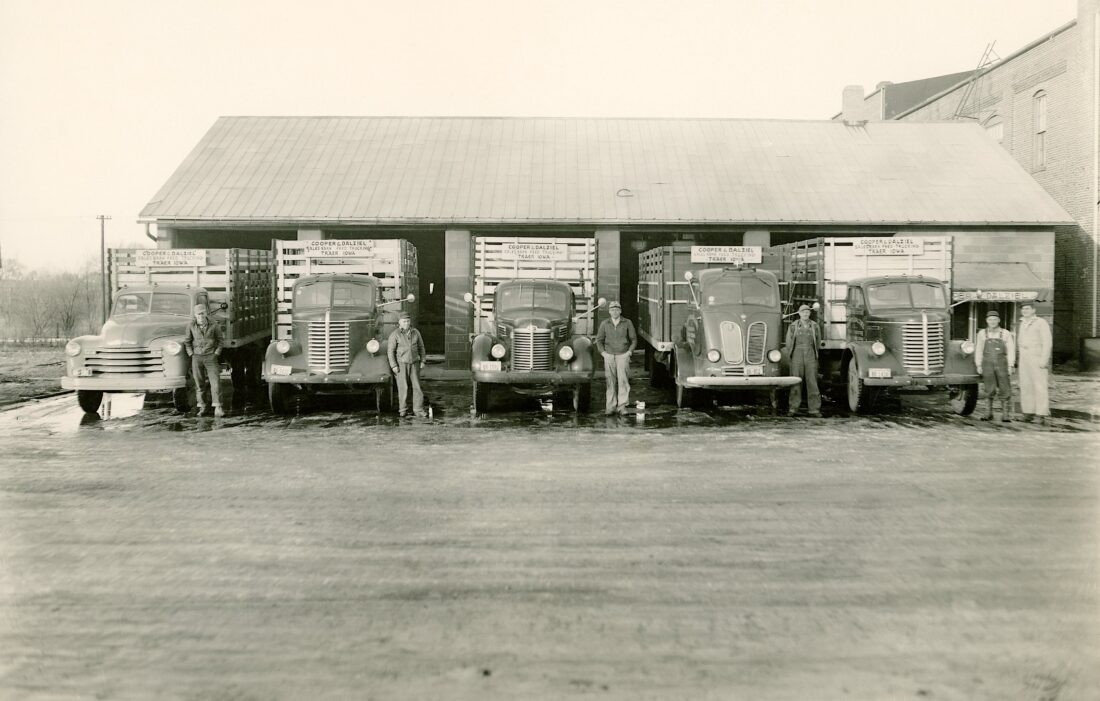
The five-truck fleet of Cooper & Dalziel pictured in 1949. From left, Leonard Ruzicka, Wilfred “Boob” Speirs, Rudy Ruzicka, Dean McConnel, Elza Buchanan, and Earl Hoeppner. The general livestock trucking business sold feed at 408 Second Street, currently the Wild Hair Salon in downtown Traer. PHOTO COURTESY OF TRAER HISTORICAL MUSEUM
Hoeg & Ames Well Drillers from Lincoln, Iowa drilled a 346-foot-deep well with a Fairbanks Morse pumping system to provide water for the facility. Andrew and Walter Richmond completed the painting and sign lettering.
Opening day at the new pavilion drew a crowd of about 1,500 people. The large barn and the spacious parking lot were said to be among Iowa’s finest. Sales were held every Wednesday. Felix E. Nissen served as auctioneer in both old and new sale barns for over 20 years. Kenneth Gates served as clerk, bookkeeper and office man.
Cooper & Dalziel also had a general livestock trucking business and sold feed at 408 Second Street, currently the Wild Hair Salon in downtown Traer. Earl Hoeppner served as foreman of the five truck fleet with Leonard Ruzicka, Wilfred “Boob” Speirs, Rudy Ruzicka, Dean McConnell, and Elza Buchanan as drivers.
On February 1, 1959, Merle Dalziel sold his interest in the Traer Sales Company to Earl Hoeppner and retired. Kenneth Gates also became a partner. The Traer Sales Co. served the farmers and buyers of this area for many years with weekly sales and other special events.
The work of the sale barn personnel was not limited to the day of the sale. Sale Barn personnel visited farmers to line up livestock for sale day and often gave estimates of what the livestock would bring. They encouraged buyers to attend the sale to buy livestock for slaughter houses. It was common for buyers from packing plants like Rath in Waterloo and Wilson’s in Cedar Rapids to send buyers for cattle and sheep. The sale barn also served as a daily buying station for fat hogs.
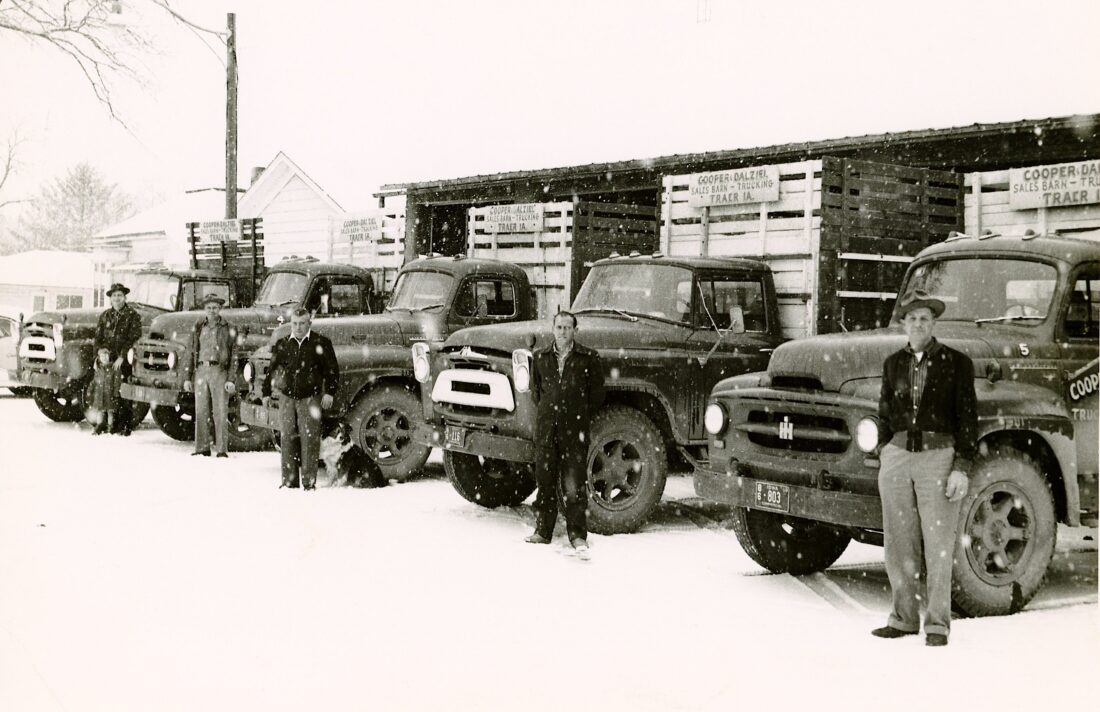
Cooper & Dalziel livestock drivers pictured in 1959. From left, Earl Hoeppner and his daughter Jane, Harold Bergman, Wilfred Speirs and Shep, LeRoy Staker, and Dean McConnell. PHOTO COURTESY OF TRAER HISTORICAL MUSEUM
The business was sold in 1971 and became the Traer Auction Co., owned by Ernie Podhajsky, William Podhajsky, Robert Podhajsky, Loren Ewoldt and Tom Smith. Smith was the manager and his wife Trudy Smith worked in the office. Kenneth Gates remained as bookkeeper.
In 1981, Traer Auction Company was sold to the Tama Sale Barn, a corporation of 20 shareholders. Dennis Wieben was president at the time. The sale barn continued holding Wednesday livestock auctions and buying fat hogs.
Auctioneers over the years included Feliz Nissen, Neils Schmidt, Jim Rohodes, Dick Dinsdale, Tom Smith and Mark Smith.
The café at the sale barn had a history of its own. The earliest café was a chicken coop across the alley from the original sale barn. It had no electricity and bottled gas for cooking and standing room only to buy food.
Merle Dalziel’s wife, Marguerite had charge of the cafe at the new sale barn and was almost as well known by patrons as her husband. She ran the café from the first day it opened until her death in 1956. Maurine McConnell took over management, having been Mrs. Dalziel’s assistant for 10 years.
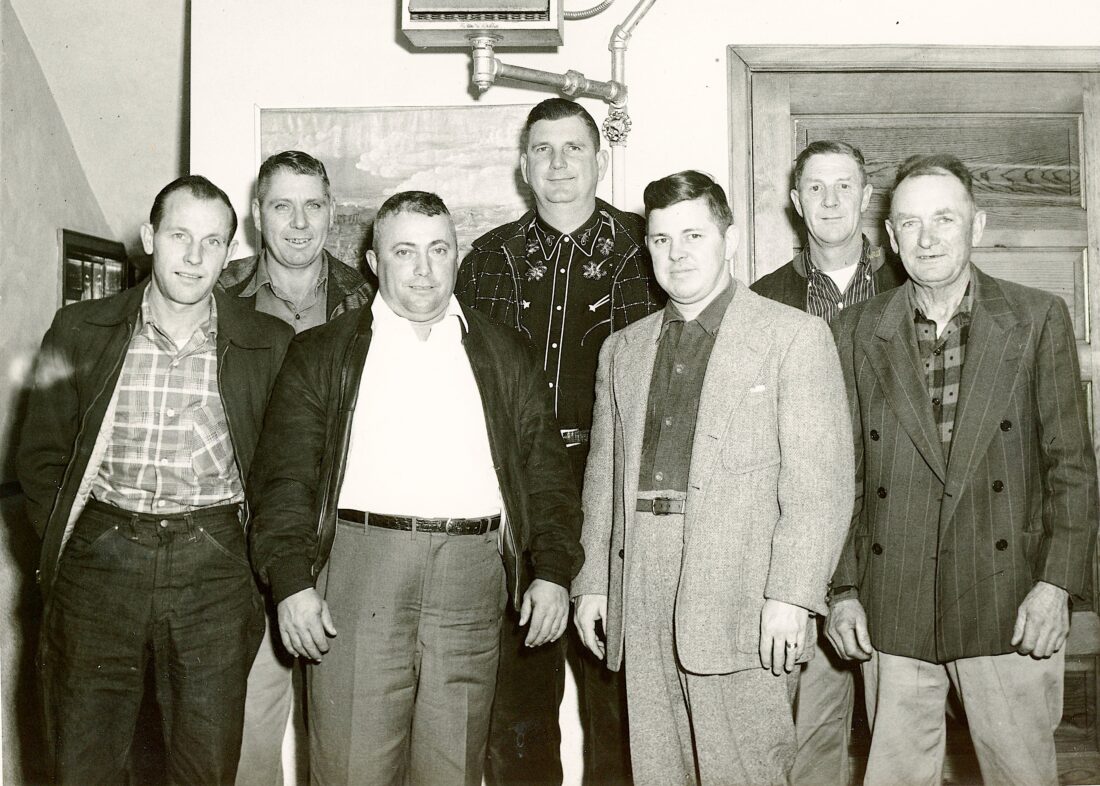
Employees with Traer Sales Company pictured in 1959. From left, Leroy Staker, Harold Bergman, Wilfred “Boob” Speirs. Earl “Hep” Hoeppner, Kenneth Gates, Dean McConnell, and Wesley Rebik. PHOTO COURTESY OF TRAER HISTORICAL MUSEUM
The St. Paul Catholic Rosary Society ran the café for several years. Norma Novotny and Pauline Ewoldt operated the café from 1971 until the sale barn closed.
In 1983, Magna International of Toronto, Canada, and its subsidiary, Dieomatic purchased the property to build Traer Manufacturing. The final livestock sale was held on Nov. 4, 1983, and shortly afterward construction began on the manufacturing plant for automotive and agricultural parts.
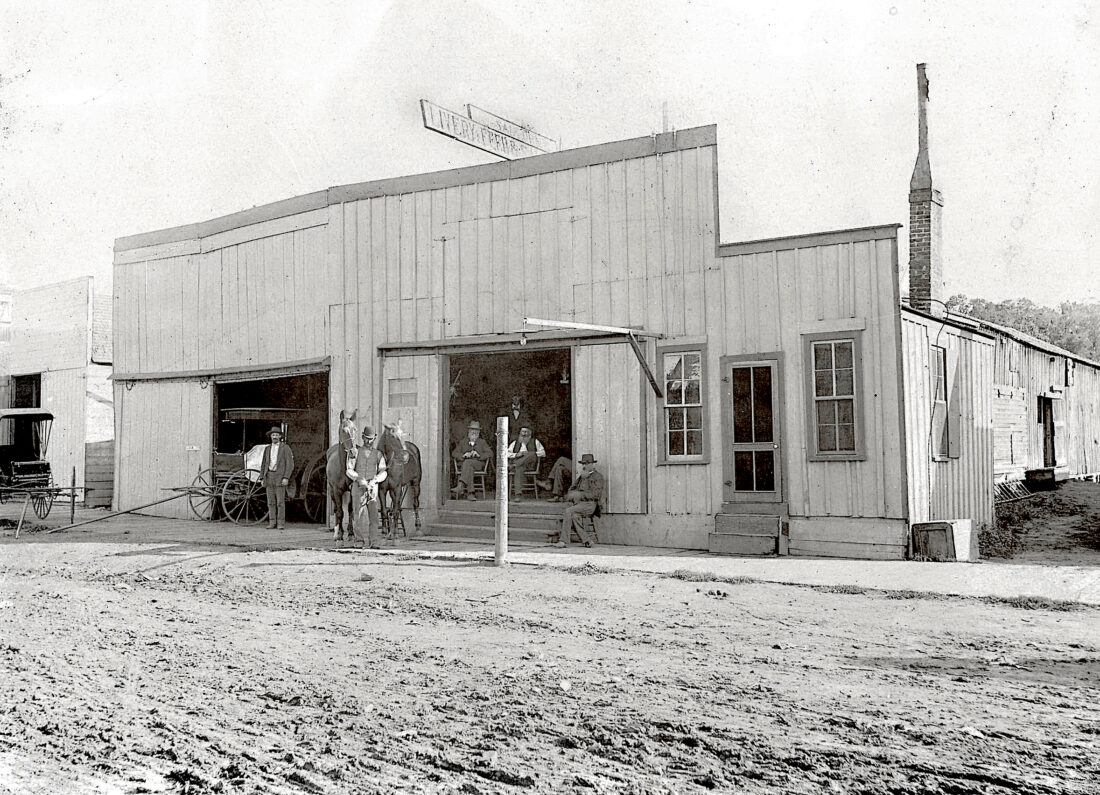
The Traer livery stable; date unknown. The first livestock sale barn in Traer was built in 1935 by Floyd Smith. The office and scale were located on Berlin Street at the junction with the alley behind Woodlawn Avenue. PHOTO COURTESY OF TRAER HISTORICAL MUSEUM

An aerial view of Traer Sales Company located south of Traer. PHOTO COURTESY OF TRAER HISTORICAL MUSEUM



